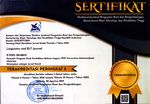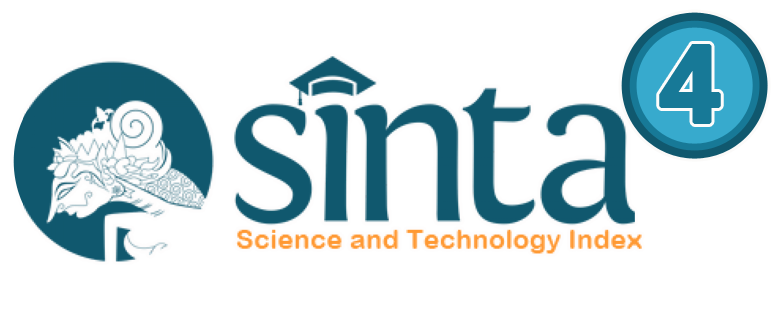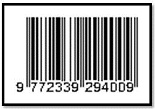A Corpus – Based Rhetorical Moves of English Research Article Abstracts on Undergraduate Thesis STKIP PGRI Pacitan
Abstract
As we know that abstract has an important role in the research article. Besides, it has its own organizational framework. Every researcher must create an abstract after the research project was completed. This article aims to identify the rhetorical moves of English abstract articles on undergraduate theses at STKIP PGRI Pacitan. The analysis guideline was based on Hyland's theory (2004). The data were collected from 20 abstracts of published journal articles. The results revealed that all moves were appeared on the students’ abstract organization. However, it was found that the degree of occurrence or the frequency appearance was differed in every moves. The data informed that moves 3 and moves 4 were found in all students’ thesis abstracts. Moves 5 appeared in 12 students’ thesis abstracts. Then, moves 1 appeared in 8 students’ thesis abstracts and moves 2 appeared in 19 students’ thesis abstracts. The findings also revealed that there were many rhetorical organizations generated by the occurrences of moves and steps in students' abstracts. The variation moves that created by students depend on the students’ writing ability. This study can be a bridge to fill the gap in improving the quality of students’ writing, especially about abstract article.
Keywords
Full Text:
PDFReferences
F. A. Sheikha and D. Inkpen, “Generation of formal and informal sentences,” Enlg 2011 - 13th Eur. Work. Nat. Lang. Gener. Proc., no. September, pp. 187–193, 2011.
P. M. Yates, “Treatment of Sexual Offenders : Research , Best Practices , and Emerging Models,” vol. 8, no. 3, pp. 89–95, 2013.
A. Chalak, “Rhetorical moves and verb tense in abstracts : A comparative analysis of American and Iranian academic writing,” no. January 2013, 2014.
L. L. T. Journal, L. L. T. Journal, and L. Learning, “Sanata Dharma University, Yogyakarta, Indonesia,” vol. 23, no. 1, pp. 168–181, 2020.
M. N. Alhuqbani, “Genre-Based Analysis of Arabic Research Article Abstracts across Four Disciplines,” J. Educ. Soc. Res., no. September 2013, 2013, doi: 10.5901/jesr.2013.v4n3p371.
A. R. Nabu, “Rhetorical Moves and Linguistic Realization: Corpus-Based Analysis of Bachelor Theses Abstracts in Islamic University,” Al-Lisan, vol. 8, no. 2, pp. 171–188, 2023, doi: 10.30603/al.v8i2.3756.
M. Vasheghani Farahani, “Metadiscourse: Exploring Interaction In Writing, Second Edition By KenHylandBloomsbury Academic. ISBN PB: 978‐1‐3500‐6358‐7. Price €179.53 (hardcover). 279 pages.,” TESOL J., vol. 12, no. 2, 2021, doi: 10.1002/tesj.575.
V. K. Bhatia, A. Genre, L. Use, P. Settings, G. Analysis, and T. Preliminaries, “Review article On Vijay K . Bhatia : Analysing Genre : Language Use in Professional Set- tings ( 1993 ) Genre Analysis - Step by Step,” no. 19, pp. 207–240, 1997.
G. Myers, “Book Reviews M . Hewings ( Ed .), Academic Writing In Context : Implications and Applications,” vol. 32, no. 2, pp. 1–4, 2009.
S. Hesse-Biber, “Qualitative approaches to mixed methods practice,” Qual. Inq., vol. 16, no. 6, pp. 455–468, 2010, doi: 10.1177/1077800410364611.
I. Askehave and J. M. Swales, “Genre identification and communicative purpose: A problem and a possible solution,” Appl. Linguist., vol. 22, no. 2, pp. 195–212, 2001, doi: 10.1093/applin/22.2.195.
T. N. Fitria, “Structure Analysis of English Abstracts in International Journal Published in 2020,” J. English Lang. Cult., vol. 12, no. 1, pp. 57–71, 2021, doi: 10.30813/jelc.v12i1.2815.
C. T. K.-H. Stadtländer, “Qualitative, Quantitative, and Mixed-Methods Research,” Microbe Mag., vol. 4, no. 11, pp. 485–485, 2009, doi: 10.1128/microbe.4.485.1.
J. Mackiewicz, A Mixed-Method Approach. 2018. doi: 10.4324/9780429469237-3.
S. C. Weigle, “Second language writing expertise,” Expert. Second Lang. Learn. Teach., pp. 128–149, 2005, doi: 10.1057/9780230523470_7.
DOI: https://doi.org/10.31764/leltj.v12i2.27901
Refbacks
- There are currently no refbacks.
Copyright (c) 2024 Mufida Nadira Yuni Pureka, Indah Puspitasari

This work is licensed under a Creative Commons Attribution-ShareAlike 4.0 International License.
_____________________________________________________
Linguistics and ELT Journal
p-ISSN 2339-2940 | e-ISSN 2614-8633

LELTJ is licensed under a Creative Commons Attribution-ShareAlike 4.0 International License.
_____________________________________________________
LELTJ is abstracting & indexing in the following databases:
_____________________________________________________
LELTJ Editorial Office:













